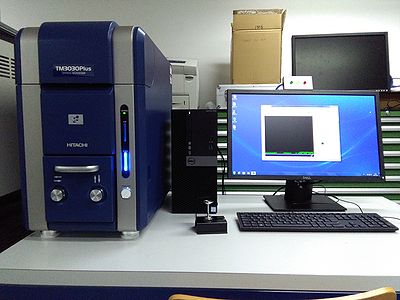Specific Process Knowledge/Characterization/SEM Tabletop 1: Difference between revisions
| Line 47: | Line 47: | ||
{| border="2" cellspacing="0" cellpadding="2" | {| border="2" cellspacing="0" cellpadding="2" | ||
!colspan="2" border="none" style="background:silver; color:black; | !colspan="2" border="none" style="background:silver; color:black;"|Equipment | ||
|style="background:WhiteSmoke; color:black"|<b>SEM Tabletop 1 (Hitachi TM3030 Plus )</b> | |style="background:WhiteSmoke; color:black"|<b>SEM Tabletop 1 (Hitachi TM3030 Plus )</b> | ||
|- | |- | ||
!style="background:silver; color:black" | !style="background:silver; color:black" rowspan="1"|Purpose | ||
|style="background:LightGrey; color:black"|Imaging and measurement of | |style="background:LightGrey; color:black"|Imaging and measurement of | ||
|style="background:WhiteSmoke; color:black"| | |style="background:WhiteSmoke; color:black"| | ||
| Line 58: | Line 58: | ||
* Thick polymers, glass or quartz samples | * Thick polymers, glass or quartz samples | ||
|- | |- | ||
!style="background:silver; color:black; | !style="background:silver; color:black;" width="60"|Location | ||
|style="background:LightGrey; color:black"| | |style="background:LightGrey; color:black"| | ||
|style="background:WhiteSmoke; color:black"| | |style="background:WhiteSmoke; color:black"| | ||
* Basement of DTU Danchip | * Basement of DTU Danchip | ||
|- | |- | ||
!style="background:silver; color:black;" | !style="background:silver; color:black;" width="60"|Performance | ||
|style="background:LightGrey; color:black"|Resolution | |style="background:LightGrey; color:black"|Resolution | ||
|style="background:WhiteSmoke; color:black"| | |style="background:WhiteSmoke; color:black"| | ||
| Line 69: | Line 69: | ||
The resolution is strongly dependent on the type of sample and the skills of the operator. | The resolution is strongly dependent on the type of sample and the skills of the operator. | ||
|- | |- | ||
!style="background:silver; color:black" align="center" valign="center" rowspan=" | !style="background:silver; color:black" align="center" valign="center" rowspan="4"|Instrument specifics | ||
|style="background:LightGrey; color:black"|Detectors | |style="background:LightGrey; color:black"|Detectors | ||
|style="background:WhiteSmoke; color:black"| | |style="background:WhiteSmoke; color:black"| | ||
| Line 94: | Line 94: | ||
* Charge-up reduction vacuum mode: 50 Pa | * Charge-up reduction vacuum mode: 50 Pa | ||
|- | |- | ||
!style="background:silver; color:black" | !style="background:silver; color:black" rowspan="3"|Substrates | ||
|style="background:LightGrey; color:black"|Batch size | |style="background:LightGrey; color:black"|Batch size | ||
|style="background:WhiteSmoke; color:black"| | |style="background:WhiteSmoke; color:black"| | ||
Revision as of 15:18, 24 January 2017
Feedback to this page: click here
THIS PAGE IS UNDER CONSTRUCTION

SEM Tabletop 1
The SEM Tabletop 1 is a scanning electron microscope. It produces enlarged images of a variety of specimens. This important and widely used analytical tool provides exceptional resolution and depth of field and requires minimal specimen preparation.
The SEM is very fast and easy to use. Sample loading can be done fast and easy. It is not needed to perform much optimization in order to obtain good SEM images.
However, it has a limited resolution compared to the other SEMs at Danchip, but for inspection of samples with structures in the micrometer range it is very fast and easy to use.
Many sample materials are allowed in the this SEM, including all standard cleanroom materials and some biological samples, if they have been approved by Danchip.
The stage can be moved manually in the X and Y directions by turning two knobs in the
The SEM can be operated in different pressure modes: Conductor, standard and charge-up reduction. By increasing the pressure in the chamber it is possible to image isolating samples. The higher density of gas molecules will eliminate the charges at the cost of slightly reduced resolution. Thus the charge-up reduction mode makes it possible to obtain SEM images of most samples including non-conducting samples without much sample preparation.
The SEM is equipped with two detectors: A secondary electron (SE) detector and a backscatter (BSE) detector.
The SEM is the training SEM at DTU Danchip. It means that all new SEM users with no or little SEM experience must be trained on this tool and gain basic knowledge here before being qualified for training on other SEM's.
The SEM Tabletop 1 was installed at Danchip in January 2017.
cleanroom before SEM inspection.
The Balzer Sputter is located in the same room as the SEM Supra 1 and can be used to cover samples (for instance polymer samples from the Polymer Injection Molding tool) with a thin gold layer before SEM inspection to avoid charging problems.
Only users with samples that are somehow related to the cleanroom can use this SEM. Other users will have to contact DTU CEN.
The user manual, control instruction, the user APV and contact information can be found in LabManager:
SEM Tabletop 1 info page in LabManager,
Performance information
Equipment performance
| Equipment | SEM Tabletop 1 (Hitachi TM3030 Plus ) | |
|---|---|---|
| Purpose | Imaging and measurement of |
|
| Location |
| |
| Performance | Resolution |
The resolution is strongly dependent on the type of sample and the skills of the operator. |
| Instrument specifics | Detectors |
|
| Stage |
| |
| Electron source |
| |
| Operating pressures |
| |
| Substrates | Batch size |
|
| Allowed materials |
| |
